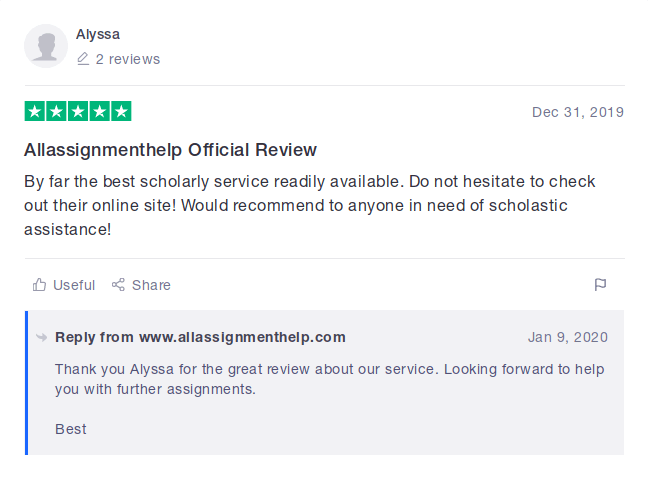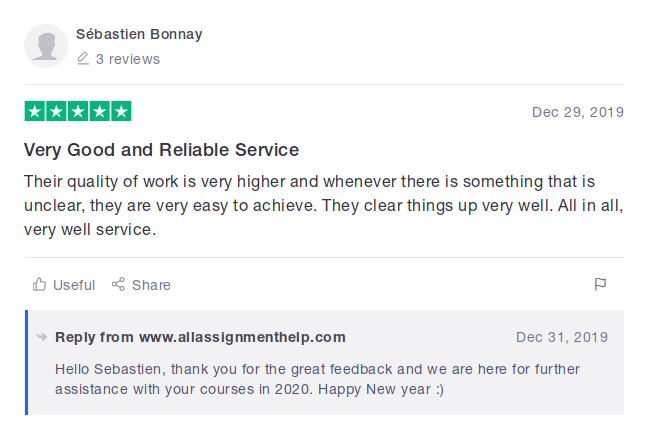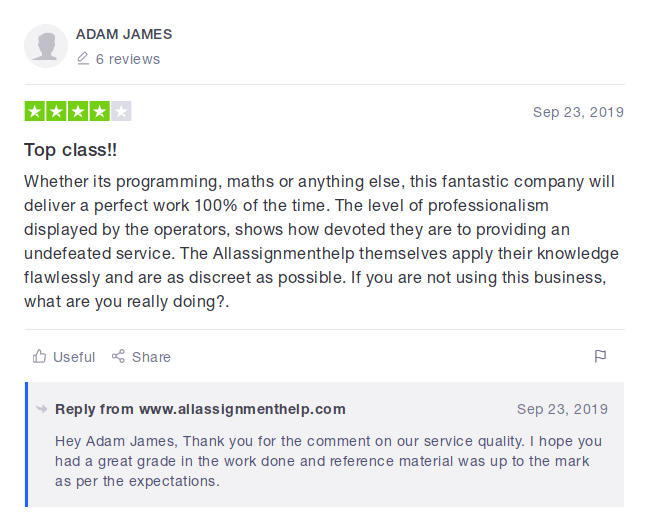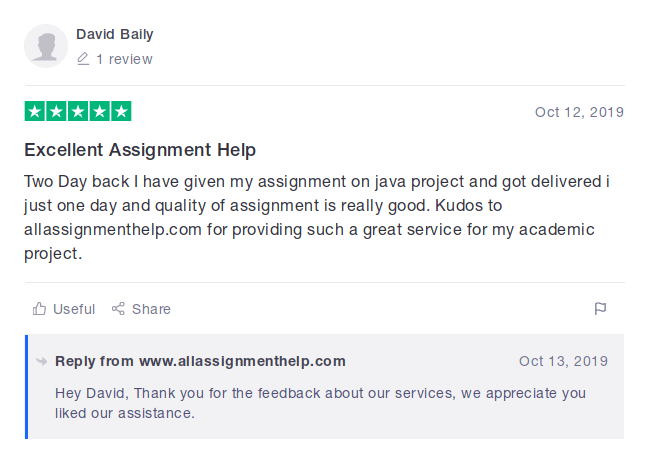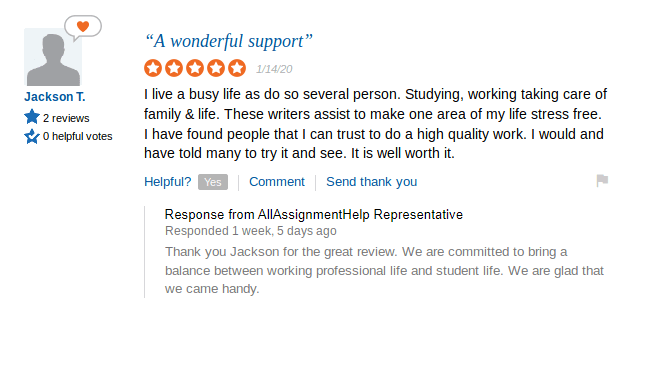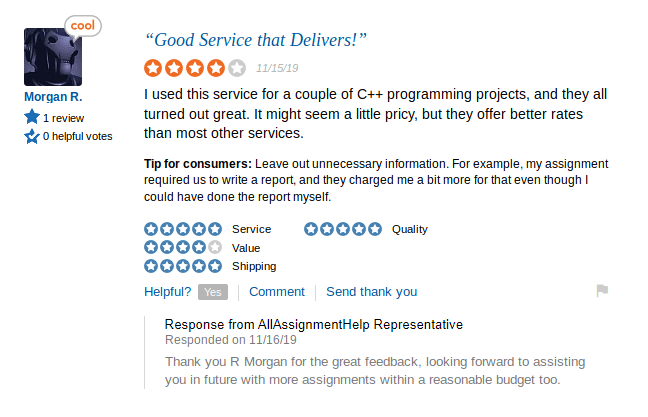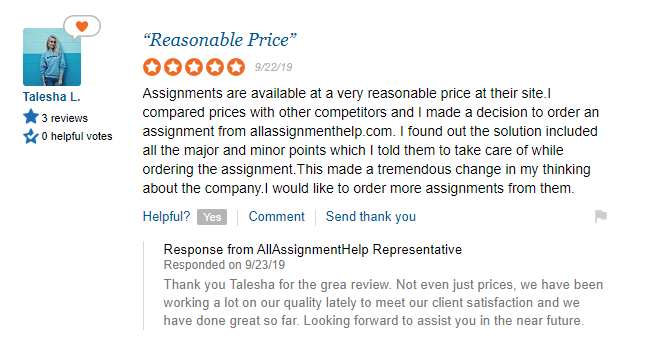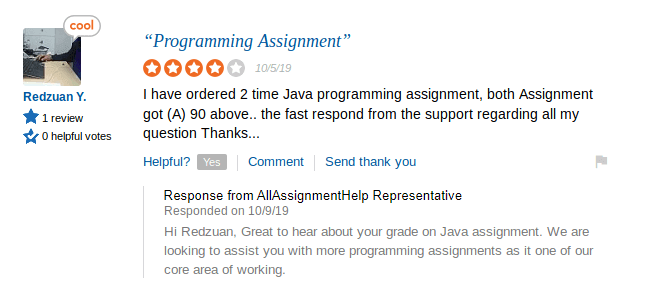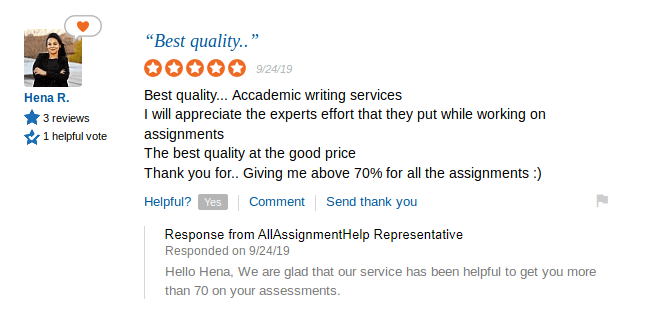Why students order last minute assistance with assignments from us
You have the flexibility to chose an assignment expert that suits your budget and quality parameters. We have more than 2000 PhD experts available to assist with assignments.
-
Order Preview Before Final Work
You get a preview before making final payment.
-
Pay Using different channels
You can pay using multiple secure channels, such as PayPal or Credit Cards.
-
Plagiarism Free Work Guaranteed
We sent unique content with no plagiarism.
-
Ping Us On Live Chat
You can talk to us anytime around the clock. We are up for the support.
-
Choose Your Own Expert
We let you chose from the pool of 2000 PhDs tutors.
-
Go Mobile
You do not need to be on laptop all the time, our mobile interface is great to use.
Reviews and Trust Go Hand In Hand
Allassignmenthelp.com has garnered nothing but praise from the clients. Any trustworthy review platform has positive review about our service and gives us motivation to improve.
Claim Your Offer
25% OFF & 100% Cashback on your First order !
Type your whatsapp number to get an exclusive code.
Recent Completed Projects
You can look at some of the samples that we did recently, we strongly recommend not to use samples for writing your assignment.
Now you don't have to wander anymore
Come to us for any type of assignment help, we do it all
Place Your OrderOverview
The current organization has identified that the expenses has increased dramatically on the health products.Added to that, it has been observed that investment on the health investment has gone beyond the investment on the other aspects of the organization. Therefore, considering this situation, it has been concluded that the right development in the field is the only way that can help in resolving the substantial investment on the medical. There are multiple projects that have been realized by the firm.These projects have the possibility of helping it in reducing the cost on the medical activities.
The current paper is divided into various chapters where the different chapters take care of particular aspects that can help in effective project management. The chapter on the project hierarchy has tried to explain the theoretical and practical elements of the project, program and portfolio management. The chapter on the project methodology has tried to explain the advantages of the project methodology and other associated elements. The chapter on metrics and measurement will talk about the metrics that are suitable for the program alignment and other associated important elements such as Balanced Scorecard.
Project Hierarchy
Project hierarchy covers the three important aspects, namely, project management, program management, and portfolio management (Morris & Pinto, 2010). The current chapter will differentiate between these three management and the similarities that exist among them. Added to that, the advantages and disadvantages of managing projects at program and portfolio levels have been discussed in the second sub-section. The organizational structure for the organization has been shown in the third section.
Project, Program and Portfolio Management
The project management is the lowest element in the hierarchy of project, program and portfolio management. The project management focuses on the appropriate management of the activities that are defined during the project planning stage.As per the current organization is concerned, it can be stated that implementing the methods which can assist in delivering the drug is necessary.
On the other hand, the program management is one step above to the project management and it is the culmination of multiple projects together. Here, it should be noted that the projects combined within a program is focused towards the achievement of single goal. In a program, only those projects are brought together that are related with one another in some way or the other (Blomquist& Muller, 2006). The projects are combined together to ensure that the goal that cannot be achieved by one project, can be achieved by combining few associated projects together.
As per the current case is considered, it can be stated that the various types of projects that are closely associated and will be brought together are research and development project for drugs, building relationship with the suppliers who will assist in resource management, training the team of researchers, and others.
The portfolio management is one step higher than the program management. The combination of various programs together is considered as a portfolio. In a portfolio, it is not mandatory that all the projects will be related to each other. There can be unrelated projects also. However, it is important to ensure that the entire portfolio is helping the organization in achieving its goals and objectives. As per the current case is concerned, it can be stated that the cost on the drug delivery is to be reduced. This can be achieved through the combination of appropriate programs together that can help the organization achieve the goal.
As stated above, there exist differences and similarities among these three aspects. The management of the project requires that the project manager showcases successful ability to execute the activities. The project manager should be able to handle each of the activities within the project appreciably well. On the other hand, as per the program management is concerned, it can be stated that the program manager should be more oriented towards governance rather than execution.
The program manager should be able successfully align the various related projects together towards a goal while ensuring that unnecessary resources are not wasted on the projects that are less useful. On the other hand, the portfolio management requires the top management to depute a portfolio manager who has the understanding of goals and objectives of the whole organization (Müller et al, 2008). The portfolio manager should be able assess the combined performance of all the programs together and align them towards the organization.
"I was doubtful before taking assignment help in the initial stages. But once they delivered my assignment, I found them perfect in every aspect. From formatting to content and editing, everything was flawless. I am pleased with the expert writing services of AllAssignmentHelp."
Eleanor Wilson,
London
Managing Projects
There is minor differencein the way project is managed at the program level and at the portfolio level. At the program level, the project manager will be able to combine various related projects together for the achievement of one goal. One of the beneficial aspect in the program management is that the program manager gets the opportunity to bring those projects under consideration that are not in scope of the main project but can aide in the development. This allows better combination of right kind of projects in achieving the goal. However, there is also a disadvantage associated with the allowance of projects together in the program. There is the possibility that the project manager may focus more on the management of the project that matter less. This can be mitigated by ensuring that the project manager stay focused on the program goal.
As per the current project is concerned, it can be stated that there is the possibility that the program manager, instead of focusing on drug development might spend substantial focus on the management of the resources that are required to reach the goal. This divided focus is the major concern of program management.
The project management under portfolio is somewhat different in comparison to the program management. Under the portfolio management less focus in given on the project level management and focus rises to the program level. Therefore, it is always considered that the focus of the portfolio is to ensure that the program stays in harmony to the organizational goals while the alignment of the project is taken care of by the program manager. This orientation also ensures that the project that does not assist in achievement of the goal of a portfolio management is eliminated (Killen et al, 2008). The disadvantage in this level is that the portfolio manager might not be able to view the project level activities and will not be able to ascertain whether particular project activities are beneficial.
Organizational Structure
The portfolio and program management should be structured in a manner that it provides maximum benefits to the organization. The alignment of the projects, programs, and portfolio should be in a manner that it can help in achievement of the organizational strategic goal. It has been observed that in most of the organizations, the top management face challenge in effectively align all the projects together so that it can help in the gaol achievement (Martinsuo&Lehtonen, 2007).
The interesting aspect is that project getting lost in achieving its individual goal is common and in this case, it becomes challenging to manage the overall goal of the organization if the individual level project goals are not managed effectively. Therefore, this requires constant monitoring and control which can be done using the right organizational structure.
The diagram above shows the organizational structure that has been developed for the current organization. In the above diagram, five levels are shown where the bottom three levels are concern for the current paper. As visible from the above diagram, the portfolio level consists of various programs that eventually handle various projects within itself.
This appropriately structured management as shown above is likely to help the current organization is achievement of its goal which is right drug delivery at lowest cost.
Place Order For A Top Grade Assignment Now
We have some amazing discount offers running for the students
Place Your OrderProject Methodology
The project methodology is concerned with the application of right method that can help in the appropriate achievement of project goals and objectives. The current chapter is concerned with understanding the key advantages to the organization when it has a project methodology. Moreover, various components of project methodology have been discussed for each of the stage of program life cycle. Finally, potential challenges for the project method implementation has been discussed.
Advantages of Project Methodology
Academicians and practitioners have identified that the use of a project methodology within the organization helps in effective management of the activities (Joslin& Müller, 2015). The project management based on certain methodology ensures better overview of the entire actives and weaving them together for right goal achievement. There are various preliminary activities that are conducted prior to engaging in the project management such as the assessment of the risks, identification of right resources, and others. These might be left alone if the project methodology is not adopted effectively.
Added to that, the project methodology helps the project manager in effectively consulting with the stakeholders and building better relationship. The project methodology, if implemented right, can increase the communication among the stakeholders which can further increase the project effectiveness. Here it can be stated that the entire project within the current organization should be following the same project methodology.
The reason behind this suggestion is that if the entire project will follow the same methodology then it will be easier to transfers employees from one project to another. However, if the different methodology will be used, then it is likely that the individual who is entering into a project in the middle might have to understand and adjust to the new project pattern every time which will be time consuming and might impact the project.
Moreover, if particular individual from the project leaves the project in the middle then it is likely that the project manager will face challenge in bringing in fresh talent whereas if the same method is being used as that of other projects within the organization, then people from other department can be borrowed easily.
Project Methodology Components
There are four components to the project methodology and they are initiation, planning, execution, and closure. These components are used at the various stages of program life cycle. The program life cycle consists of three levels in general, that is, program definition, program benefits delivery, and the program closure.
It is clear from the nomenclature that the project closure mostly aligns with the program closure stage. The program definition is concerned with the initiation of the projects within the program. The first stage of the program life cycle includes program formulation and preparation. Here the various projects are considered. Therefore, it is important that the goals of projects are also defined at this stage.
Place Order For A Top Grade Assignment Now
We have some amazing discount offers running for the students
Place Your OrderProject Methodology Recommendations
The project methodology that has been recommended for the current organization is PRINCE2. This methodology is widely used by the organizations around the world. The most important benefit in this methodology is that it provides right assistance in engaging the stakeholders together which is likely to be utilized in the current organization to higher level (Saad et al, 2014). There are various project methodologies, yet PRINCE2 has been selected. The reason for the same is discussed along with the brief on various methods as below:
Waterfall Project Management
The waterfall method is the traditional form of project management where one activity follows another. The alignment of the project activities within this methodology is rigid and thus allows almost no freedom (Verzuh, 2015). This is not recommended for the current organization as the flexibility will be a must criterion for the drug development.
Agile Project Method
If the project activities require constant updates based on the stakeholders’ feedback, only then this project method will be highly successful (Conforto et al, 2014). However, in the current no major improvisation or change in project activities is required for the current organization and thus this method does not seem suitable.
Critical Chain Path
The critical chain path method only considers the activities that are critical to the success of the goal (Leach, 2014). However, in the current drug development, the combination of myriad activities are suggested and therefore, this method is not suited.
PRiSM
PRiSM stands for Projects Integrating Sustainable Methods. This method is used in the construction activities where the inclusion of sustainability aspects has become a necessity (Lewis et al, 2015). However, there are no such needs at present for the current organization, therefore this is not suggested.
PRINCE2
This method was developed by the United Kingdom government. This method allows the project management team or program manager to bring the changes in the project methodology as suited for the entire organization. Moreover, it ensures active engagement of stakeholders such as suppliers, clients, and others. Here, this method has been chosen for the current organization.
Note: This is not a complete solution. You can request the complete solution by filling out the order form towards your requested assignment.
Place Order For A Top Grade Assignment Now
We have some amazing discount offers running for the students
Place Your OrderREFERENCES
Blomquist, T., & Müller, R. (2006). Middle managers in program and project portfolio management: Practices, roles and responsibilities. Project Management Institute.
Conforto, E. C., Salum, F., Amaral, D. C., da Silva, S. L., & de Almeida, L. F. M. (2014).
Can agile project management be adopted by industries other than software development?. Project Management Journal, 45(3), 21-34.
Dinsmore, P. C., &Cabanis-Brewin, J. (2006). The AMA handbook of project management.AMACOM Div American Mgmt Assn.
Hoque, Z. (2014). 20 years of studies on the balanced scorecard: trends, accomplishments, gaps and opportunities for future research. The British accounting review, 46(1), 33-59.
Joslin, R., & Müller, R. (2015).Relationships between a project management methodology and project success in different project governance contexts. International Journal of Project Management, 33(6), 1377-1392.
Killen, C. P., Hunt, R. A., &Kleinschmidt, E. J. (2008).Project portfolio management for product innovation. International Journal of Quality & Reliability Management, 25(1), 24-38.
 +1-817-968-5551
+1-817-968-5551 +61-488-839-671
+61-488-839-671 +44-7480-542904
+44-7480-542904


